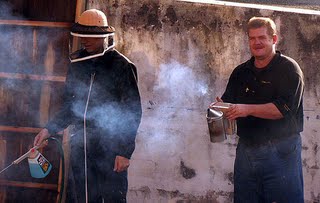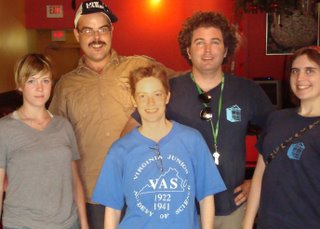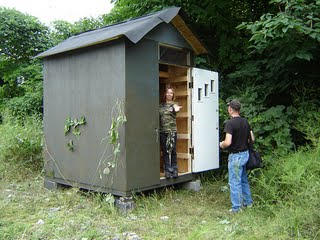Awesome video
Dec 16, 2009
This video essay was done by Amanda Gardner (www.agardnerphoto.wordpress.com). Thanks, Amanda!
Another email
Nov 28, 2009
In response to a person who wrote asking what sort of design help the Mad Housers could use. My edited response:
The Mad Housers have long tried to balance between the issues of 'more' and 'better' when it comes to shelter. Given a limited (VERY limited) amount of resources, do we want to make fewer, better shelters or more, skimpier shelters?
Until recently, we've been mostly on the 'more' side - most of our design changes have been the type that help improve the longevity of the shelters (roof overhangs) or give great improvement at little additional cost (hi hats). However, our our Board is now beginning to think that certain quality-of-life improvements may help with the longevity of the camp as a whole. Simply put, if we start making additional investments in things that aren't directly shelter, such as building toilets or adding solar electrification, the quality of the camp may help convince outsiders that we're a net benefit to the community. Currently, even the best-run homeless camps are dicey propositions at best. Anything we can do to improve a camp's chances of survival should be considered.
So there's our challenge: right now, we're focused 100% on basic shelter. What other things can we do to make an encampment a better place to live? Once we start looking at things beyond simple shelter, there are lots of needs that our clients have. Hygiene. Communication. Transportation. Power. Storage. Food preparation. Community.
Here are our design constraints:
- It should be a capital improvement, not an ongoing service. In other words, we can build a woodshed, but we're not going to start up firewood delivery.
- It needs to be buildable by volunteers using ordinary tools and off-the-shelf materials.
- It cannot be fixed to the ground. Our shelters sit on cinder blocks, which make them chattel property. If we were to pour a foundation, we would start crossing a number of laws.
- It should give us maximum bang for our buck. Currently, one of our huts costs about $500 to build; this makes us the cheapest secure shelter solution that I've yet found. (If you can find a better one, please let us know!) Our total yearly budget is around $10,000. So a project that costs $4000 would be a huge investment of our budget that would otherwise shelter 8 people - it would have to be pretty compelling!
- Anything that requires ongoing maintenance should be maintainable by our clients. For example, we've frequently discussed building composting toilets. But who's going to service them? We're fairly certain that the first time someone gets sick in a potty, nobody will clean it, and it'll go downhill from there.
So you can see, it's a challenging problem. You could pick just about any area and work with it. What interests you?
Labels: board of directors, design, email
Nov 3, 2009
We've received some interesting emails lately, and I thought the responses might make for interesting blog posts. One volunteer wrote in recently offering several observations:
- Frequently, it seems like volunteers stand around a lot waiting for things to happen. Perhaps we could split into smaller teams to work on separate things...?
- Second, oftentimes panel loading seems chaotic, and items have been left behind at the warehouse. Checklists...?
- Third, why aren't we soliciting for volunteers more aggressively?
Yes, there's definitely an art to splitting up tasks to keep everyone engaged.
For instance, we could paint the panels before we leave the warehouse, but in general we don't. Why? Because out in the field, there's usually a period where, in terms of construction, only one or two people can be building. Instead of having folks standing around, it's better to leave off the painting at the warehouse so that folks can paint in the field, even if that seems to take more time in the field.
The problem is, you generally get to be a build leader by knowing how to build a shelter, but that winds up being only part of the skillset of directing a team to build a shelter. Hell, I've been building huts for 15 years and I still sometimes wind up having folks idling. In general, we try to keep everyone occupied, but sometimes we slip up, and sometimes circumstances wind up making it impossible. But we can't have new build leaders become good build leaders until they're done, sadly, being not-so-good build leaders.
In terms of the loading situation - we are now implementing checklists, so that's better, but the Board realizes that this is right now one of the biggest bottlenecks that we have at a build. We're setting a shoot-for-the-moon goal of having our load time for a shelter deploy thinned down to 15 minutes. That's going to require some high organization and out-of-the-box thinking, especially for circumstances where half the team doesn't know their way around the warehouse. But even if it only goes to 20 minutes, that'll still be a vast improvement.
And in terms of getting new recruits... well, there's something big in the works. Watch this space!
Labels: builds, email, logistics, volunteers
Bees!
Oct 26, 2009
 We had some 55 gallon drums by our loading dock that were donated to us by a local bakery. Unfortunately, a couple were missing bungs and they'd contained sweeteners. Hilarity ensued.
We had some 55 gallon drums by our loading dock that were donated to us by a local bakery. Unfortunately, a couple were missing bungs and they'd contained sweeteners. Hilarity ensued.
Seussicle on Stewart
Aug 21, 2009
I teach at Paideia School. After every stage production, I have been taking the old sets down to either Bankhead or Stewart where they are used for firewood or small construction.
Another great site recon
Aug 9, 2009
 Our awesome volunteers after an afternoon of talking to homeless and trekking thru the off-road geography of Atlanta.
Our awesome volunteers after an afternoon of talking to homeless and trekking thru the off-road geography of Atlanta.

